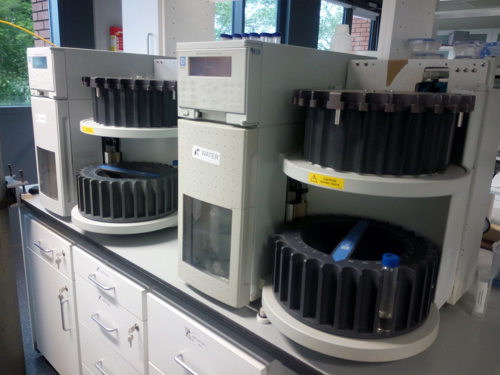Analysis of Sucrose
Click here to place an order for determining Sucrose.
Request a QuoteSucrose Content
Analysis Packages for Sucrose
Total Sugars, Glucose, Xylose, Mannose, Arabinose, Galactose, Rhamnose, Lignin (Klason), Lignin (Klason - Protein Corrected), Lignin (Acid Soluble), Acid Insoluble Residue, Extractives (Ethanol-Soluble), Extractives (Water-Soluble), Extractives (Exhaustive - Water then Ethanol), Extractives (Water-Insoluble, Ethanol Soluble) , Ash, Ash (Acid Insoluble), Glucuronic Acid, Galacturonic Acid, 4-O-Methyl-D-Glucuronic Acid, Protein Content of Acid Insoluble Residue, Carbon Content of Acid Insoluble Residue, Hydrogen Content of Acid Insoluble Residue, Nitrogen Content of Acid Insoluble Residue, Sulphur Content of Acid Insoluble Residue, Xylitol, Sucrose, Fructose, Sorbitol, Trehalose
Equipment Used for Sucrose Analysis

Ion Chromatography
A Dionex ICS-3000 system that is equipmed with electrochemical, conductivity, and ultraviolet-visible detectors.

Solvent Extractor
Dionex ASE-200 devices are used to determine the extractives (water-soluble, ethanol-soluble) contents of biomass samples.
Short-chain fructooligosaccharides (scFOS) are nutraceuticals with numerous applications in the food and pharmaceutical industries. The production of scFOS using immobilized biocatalysts offers some functional and technical advantages over free enzyme counterparts. To investigate the economic potential of the immobilized enzyme system relative to the free enzyme system, a techno-economic comparison was conducted on three methods of scFOS production (powder and syrup forms) at a capacity of 2000?t per annum (tpa) by enzymatic synthesis from sucrose: the free enzyme (FE), calcium alginate immobilized enzyme (CAIE), and amberlite IRA 900 immobilized enzyme (AIE) systems. These processes were simulated in Aspen Plus to obtain the mass and energy balances and to estimate the operating and capital costs, followed by economic evaluation and sensitivity analysis. Profitability analysis showed that all three systems are economically viable as their associated minimum selling prices (MSP) were well below the scFOS market price of 5 $ kg-1. However, the FE system was the most profitable with the lowest MSP of 2.61 $ kg-1 because the savings on cost as a result of enzyme immobilization could not offset the additional costs associated with immobilization. Sensitivity analysis demonstrated that total operating cost, fixed capital investment, and internal rate of return (% IRR) have the greatest effects on the MSP. Furthermore, the syrup form of scFOS production leads to 29% less MSP, compared to powder form. In addition, the studied plant capacities of 5000 and 1000?tpa showed 10% and 16% reductions on MSP respectively. | |
The immobilization of B-fructofuranosidase for short-chain fructooligosaccharide (scFOS) synthesis holds the potential for a more efficient use of the biocatalyst. However, the choice of carrier and immobilization technique is a key to achieving that efficiency. In this study, calcium alginate (CA), Amberlite IRA 900 (AI900) and Dowex Marathon MSA (DMM) were tested as supports for immobilizing a novel engineered B-fructofuranosidase from Aspergillus japonicus for scFOS synthesis. Several immobilization parameters were estimated to ascertain the effectiveness of the carriers in immobilizing the enzyme. The performance of the immobilized biocatalysts are compared in terms of the yield of scFOS produced and reusability. The selection of carriers and reagents was motivated by the need to ensure safety of application in the production of food-grade products. The CA and AI900 both recorded impressive immobilization yields of 82 and 62%, respectively, while the DMM recorded 47%. Enzyme immobilizations on CA, AI900 and DMM showed activity recoveries of 23, 27, and 17%, respectively. The CA, AI900 immobilized and the free enzymes recorded their highest scFOS yields of 59, 53, and 61%, respectively. The AI900 immobilized enzyme produced a consistent scFOS yield and composition for 12 batch cycles but for the CA immobilized enzyme, only 6 batch cycles gave a consistent scFOS yield. In its first record of application in scFOS production, the AI900 anion exchange resin exhibited potential as an adequate carrier for industrial application with possible savings on cost of immobilization and reduced technical difficulty. | |
Additional Material
We can determine the Sucrose content of biomass, click here to learn more about our various biomass analysis methods.
We can determine the Sucrose content of various liquids, including liquids from pre-treatment and hydrolysis processes, click here to learn more about our various methods for analysing process liquids.



